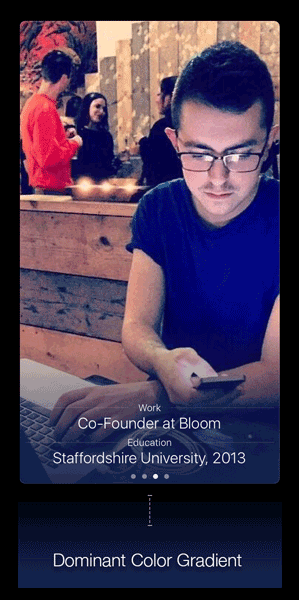
A Case Study
About
Bloom was my first foray into the startup world. Securing a small bootstrap investment, plans were drawn up, ideas developed and an app created.
This would be my first native app, and over the next 3 months I learnt Objective-C, and all that comes with it to launch our MVP, known then as Spark.
The Problem
Everyday we see people on the tube that we wish we had spoken to. But when in a cramped carriage on a Monday morning, too often we do nothing.
Bloom's Solution
A discreet way to reach out, to find out if they too are interested.
Using Bluetooth, Bloom allows people to ‘like’ each other no matter their connectivity. Likes are received only after you part ways.
Skills
- PrototypePOP, Pen and Paper
- DesignPhotoshop, Sketch, After Effects
- AppObjective-C, Cocoapods, CoreLocation
- CoreBluetooth, SpriteKit, Data Sync
- Facebook API, Parse BaaS.
- ProjectTrello, Bitbucket, Hipchat, Skype
- MarketingLondon Underground poster campaign,
- promo website, photos & videos.
Design
Bloom uses a page based design which focuses on consistent spacial awareness, creating an understanding of your place within the app at all times.
These pages are known as “Today”, showing places you visited/lingered at, “Now” showing people nearby in realtime and “Inbox” which shows people that liked you and your matches, people that have accepted your like or whose like you've accepted.
Additional views, such as profiles and today’s remaining likes are displayed ‘on top’ of the pages. They are presented and dismissed in ways that hint not only their resting place, helping people access them later, but also gestures that can be used for more natural interactions.
Aesthetically Bloom is white on black. All colour comes from the people. By analysing each person’s image for colour density, we extract a personal colour.

From ones own photo this colour is used to tint the entire app, from editing your profile or changing settings, to colouring the 'sparks' that emanate when liking someone.
When viewing someone else, we use their colour for the border, and whilst inside their profile as a background for overlaid text, maintaining legibility without interrupting the photos.

Each profile page contains a full-screen photo, optionally adorned with text, work info, school info, or what they are looking for, be it a relationship, friends, fun or all three. We relate the profile to a book, as you swipe to the next photo you are turning a page, reading the book of that person, getting to know them a little.
In direct opposition to Tinder’s swipe-happy liking system, we have a tap-and-hold gesture which takes around 2 seconds and can only be done 3 times a day. This limitation creates likes that are more special and considered.
Technology
With the renaissance of Bluetooth on our wrists and doorsteps, Bloom was positioned to be the first mainstream Bluetooth enhanced dating app.
With many of London’s young professional, commuting demographic using iPhones, Bloom was launched first on iOS, with CoreBluetooth functioning in Central and Peripheral roles simultaneously, with plans to later be extended to Android.
When two people fell within each other’s discovery preferences, gender, orientation and age, iOS would wake Bloom in the background to share basic information. Then each user would be notified that someone was on Bloom nearby, allowing them to leave Bloom in their pocket and continue with their lives.
After launching in beta our first important change was to better education people on Bluetooth, and it’s low-energy nature, with some of the most technically savvy people still believing it would drain battery life. Soon after launch CoreLocation was implemented to allow users to find people further afield, this helped people find a use for the app when not in the centre of town.
Still in beta testing, 'Today' is Bloom's latest feature, which records visits versus real-time location. This provides a different value proposition for the user, visits are only available after an area has been left, allowing a greater sense of privacy whilst also improving the potential quality of nearby people, not only including people traveling through but people who idled in that area for an amount of time. This creates a unique social angle for Bloom, where people can connect over shared experiences and mutual interest in, for example, the band whose gig they were watching, the bar popup bar they visited.
Bloom Now
Bloom is no longer in active development, but continues to be used by Londoners. Bloom currently operates at zero cost.